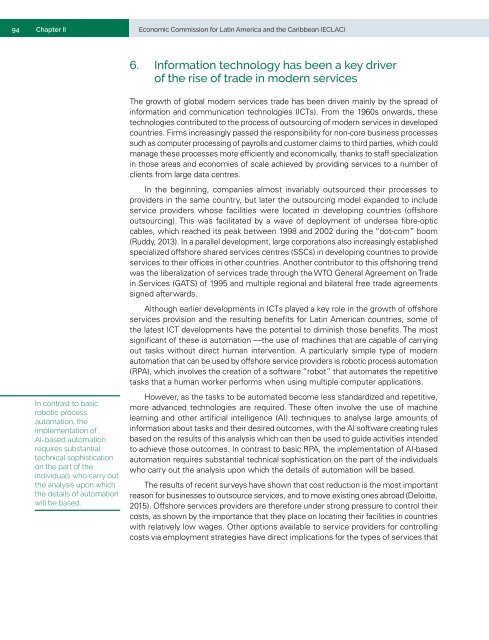International Trade Outlook for Latin America and the Caribbean: Recovery in an uncertain context
This first edition of International Trade Outlook for Latin America and the Caribbean, which is the continuation of Latin America and the Caribbean in the World Economy with a new title, covers 2017 and contains three chapters. The first chapter describes the current international context and the recovery of trade in the region. Chapter II reviews the region’s performance in global trade in services in general and in modern services in particular, since 2005. Chapter III provides an overview of Latin America and the Caribbean’s share of the world agricultural trade since 2000 and offers some policy recommendations for increasing the sector’s contribution to regional development.
This first edition of International Trade Outlook for Latin America and the Caribbean, which is the continuation of Latin America and the Caribbean in the World Economy with a new title, covers 2017 and contains three chapters. The first chapter describes the current international context and the recovery of trade in the region. Chapter II reviews the region’s performance in global trade in services in general and in modern services in particular, since 2005. Chapter III provides an overview of Latin America and the Caribbean’s share of the world agricultural trade since 2000 and offers some policy recommendations for increasing the sector’s contribution to regional development.
You also want an ePaper? Increase the reach of your titles
YUMPU automatically turns print PDFs into web optimized ePapers that Google loves.
94 Chapter II<br />
Economic Commission <strong>for</strong> <strong>Lat<strong>in</strong></strong> <strong>America</strong> <strong><strong>an</strong>d</strong> <strong>the</strong> <strong>Caribbe<strong>an</strong></strong> (ECLAC)<br />
6. In<strong>for</strong>mation technology has been a key driver<br />
of <strong>the</strong> rise of trade <strong>in</strong> modern services<br />
The growth of global modern services trade has been driven ma<strong>in</strong>ly by <strong>the</strong> spread of<br />
<strong>in</strong><strong>for</strong>mation <strong><strong>an</strong>d</strong> communication technologies (ICTs). From <strong>the</strong> 1960s onwards, <strong>the</strong>se<br />
technologies contributed to <strong>the</strong> process of outsourc<strong>in</strong>g of modern services <strong>in</strong> developed<br />
countries. Firms <strong>in</strong>creas<strong>in</strong>gly passed <strong>the</strong> responsibility <strong>for</strong> non-core bus<strong>in</strong>ess processes<br />
such as computer process<strong>in</strong>g of payrolls <strong><strong>an</strong>d</strong> customer claims to third parties, which could<br />
m<strong>an</strong>age <strong>the</strong>se processes more efficiently <strong><strong>an</strong>d</strong> economically, th<strong>an</strong>ks to staff specialization<br />
<strong>in</strong> those areas <strong><strong>an</strong>d</strong> economies of scale achieved by provid<strong>in</strong>g services to a number of<br />
clients from large data centres.<br />
In <strong>the</strong> beg<strong>in</strong>n<strong>in</strong>g, comp<strong>an</strong>ies almost <strong>in</strong>variably outsourced <strong>the</strong>ir processes to<br />
providers <strong>in</strong> <strong>the</strong> same country, but later <strong>the</strong> outsourc<strong>in</strong>g model exp<strong><strong>an</strong>d</strong>ed to <strong>in</strong>clude<br />
service providers whose facilities were located <strong>in</strong> develop<strong>in</strong>g countries (offshore<br />
outsourc<strong>in</strong>g). This was facilitated by a wave of deployment of undersea fibre-optic<br />
cables, which reached its peak between 1998 <strong><strong>an</strong>d</strong> 2002 dur<strong>in</strong>g <strong>the</strong> “dot-com” boom<br />
(Ruddy, 2013). In a parallel development, large corporations also <strong>in</strong>creas<strong>in</strong>gly established<br />
specialized offshore shared services centres (SSCs) <strong>in</strong> develop<strong>in</strong>g countries to provide<br />
services to <strong>the</strong>ir offices <strong>in</strong> o<strong>the</strong>r countries. Ano<strong>the</strong>r contributor to this offshor<strong>in</strong>g trend<br />
was <strong>the</strong> liberalization of services trade through <strong>the</strong> WTO General Agreement on <strong>Trade</strong><br />
<strong>in</strong> Services (GATS) of 1995 <strong><strong>an</strong>d</strong> multiple regional <strong><strong>an</strong>d</strong> bilateral free trade agreements<br />
signed afterwards.<br />
Although earlier developments <strong>in</strong> ICTs played a key role <strong>in</strong> <strong>the</strong> growth of offshore<br />
services provision <strong><strong>an</strong>d</strong> <strong>the</strong> result<strong>in</strong>g benefits <strong>for</strong> <strong>Lat<strong>in</strong></strong> <strong>America</strong>n countries, some of<br />
<strong>the</strong> latest ICT developments have <strong>the</strong> potential to dim<strong>in</strong>ish those benefits. The most<br />
signific<strong>an</strong>t of <strong>the</strong>se is automation —<strong>the</strong> use of mach<strong>in</strong>es that are capable of carry<strong>in</strong>g<br />
out tasks without direct hum<strong>an</strong> <strong>in</strong>tervention. A particularly simple type of modern<br />
automation that c<strong>an</strong> be used by offshore service providers is robotic process automation<br />
(RPA), which <strong>in</strong>volves <strong>the</strong> creation of a software “robot” that automates <strong>the</strong> repetitive<br />
tasks that a hum<strong>an</strong> worker per<strong>for</strong>ms when us<strong>in</strong>g multiple computer applications.<br />
In contrast to basic<br />
robotic process<br />
automation, <strong>the</strong><br />
implementation of<br />
AI-based automation<br />
requires subst<strong>an</strong>tial<br />
technical sophistication<br />
on <strong>the</strong> part of <strong>the</strong><br />
<strong>in</strong>dividuals who carry out<br />
<strong>the</strong> <strong>an</strong>alysis upon which<br />
<strong>the</strong> details of automation<br />
will be based.<br />
However, as <strong>the</strong> tasks to be automated become less st<strong><strong>an</strong>d</strong>ardized <strong><strong>an</strong>d</strong> repetitive,<br />
more adv<strong>an</strong>ced technologies are required. These often <strong>in</strong>volve <strong>the</strong> use of mach<strong>in</strong>e<br />
learn<strong>in</strong>g <strong><strong>an</strong>d</strong> o<strong>the</strong>r artificial <strong>in</strong>telligence (AI) techniques to <strong>an</strong>alyse large amounts of<br />
<strong>in</strong><strong>for</strong>mation about tasks <strong><strong>an</strong>d</strong> <strong>the</strong>ir desired outcomes, with <strong>the</strong> AI software creat<strong>in</strong>g rules<br />
based on <strong>the</strong> results of this <strong>an</strong>alysis which c<strong>an</strong> <strong>the</strong>n be used to guide activities <strong>in</strong>tended<br />
to achieve those outcomes. In contrast to basic RPA, <strong>the</strong> implementation of AI-based<br />
automation requires subst<strong>an</strong>tial technical sophistication on <strong>the</strong> part of <strong>the</strong> <strong>in</strong>dividuals<br />
who carry out <strong>the</strong> <strong>an</strong>alysis upon which <strong>the</strong> details of automation will be based.<br />
The results of recent surveys have shown that cost reduction is <strong>the</strong> most import<strong>an</strong>t<br />
reason <strong>for</strong> bus<strong>in</strong>esses to outsource services, <strong><strong>an</strong>d</strong> to move exist<strong>in</strong>g ones abroad (Deloitte,<br />
2015). Offshore services providers are <strong>the</strong>re<strong>for</strong>e under strong pressure to control <strong>the</strong>ir<br />
costs, as shown by <strong>the</strong> import<strong>an</strong>ce that <strong>the</strong>y place on locat<strong>in</strong>g <strong>the</strong>ir facilities <strong>in</strong> countries<br />
with relatively low wages. O<strong>the</strong>r options available to service providers <strong>for</strong> controll<strong>in</strong>g<br />
costs via employment strategies have direct implications <strong>for</strong> <strong>the</strong> types of services that


















